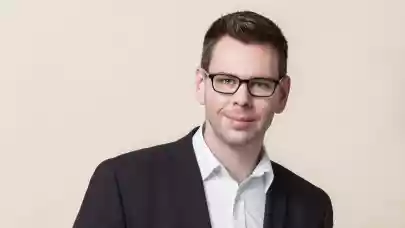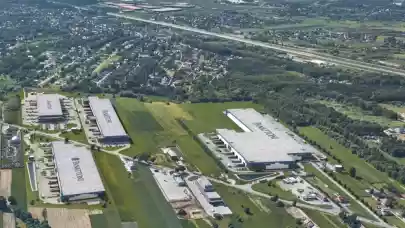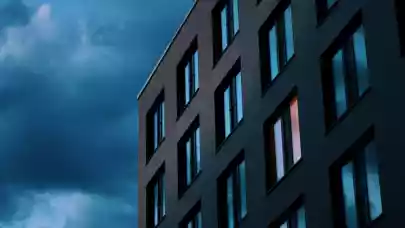
Public transport expert Dávid Vitézy, CEO of the governmental organisation Budapest Development Agency (BFK), was recently invited by RICS to join its ranks as a Fellow Member, recognizing his unique professional knowledge. On the occasion of this new appointment, he talked to Property Forum about the future he imagines for Budapest.
Being a global organization, one of the main goals of RICS is knowledge sharing. Which cities do you think Budapest can learn the most from?
I’d like to highlight three Central European cities that can be exemplary for Budapest in terms of transport and urban development – Munich, Vienna and Prague. In Munich and its agglomeration, comparable in size to Budapest’s metro area, suburban railways carry three times as many passengers as in Central Hungary. Munich is one of the richest urban areas in Europe and a major centre for car production and sales. Still, people are more willing to travel by train thanks to a reliable and extensive suburban railway system (S-Bahn) with excellent downtown connections and transfer options. In neighbouring Vienna, the old main railway station (Südbahnhof) was demolished and a new transit station (Hauptbahnhof) was built in its place as part of a long-term project of almost ten years. In the railway rust area thus freed up, a new neighbourhood (green areas, apartments, offices and shops) was created. Prague and its region is also worth mentioning because they are a few years ahead of Budapest as rail transport there is being developed and plans for further expansion are being made at a very fast pace.

Dávid Vitézy
CEO
Budapest Development Agency
Where do you get your inspiration from? Who are your role models?
I am constantly paying attention to international transport and urban development trends as the world is undergoing very dynamic and transformative changes due to global warming. I have had the pleasure of knowing Sir Peter Hendy, previous Commissioner of Transport for London and current chairman of Network Rail, for a decade now. I consider the urban development work and ideas of the re-elected mayor of Paris, Anne Hidalgo, to be very forward-looking. While Paris is known for wide boulevards full of traffic, she has put the emphasis on pedestrians, cyclists and the expansion of green spaces, having initiated very serious changes with great social support. I should also mention major cities in Asia and Australia that I simply need to pay attention to as many large-scale transport projects are currently underway there.
Stuttering projects also provide inspiration. Pretty much an entire generation has learned a lot from the case of Budapest’s metro line 4, both during the preparation and the execution of the project. I could also mention Crossrail in London, a project that is being constantly delayed in a country with a strong project culture.
There are two bi-annual events that I’ve been attending for nearly 15 years now, the UITP World Congress and Innotrans in Berlin. These two events bring together transport leaders from Europe and the world and provide so much inspiration that executing all the ideas conceived there takes several years.
But since the rail service consists not only of tracks and trains but stations are also integral parts of our cities, I pay special attention to countries where station buildings of very high architectural quality are created, making the cities, districts and public transport more attractive. This was also the case in Hungary in the 19th century – just think of the grandiose Keleti and Nyugati railway stations in Budapest. It is time for this approach to make its way back to Hungary.
Kathleen Fontana, recently inaugurated RICS President for 2020-2021 said: „As we start to think about emerging from this crisis I would urge us all to be focused not only on the short-term recovery and regain, but also on the once in a lifetime opportunity to reset and to ‘build back better’ – to continue to address the global challenges of digitalisation, sustainability and social impact. With this strategic focus, we can ensure that the assets in the natural and built environment assets are harnessed to truly promote a better future for all.” In your opinion, what new opportunities does the crisis present for Budapest?
The pandemic presented everyone with a lot of difficulties, but it showed that structures and beliefs that were believed to be permanent can be transformed surprisingly quickly if necessary and people are more open to change than we might think. I absolutely agree with Kathleen Fontana. In the spirit of post-pandemic recovery, more EU development funds are expected to be made available to Hungary for railway development than ever before. We need to take advantage of this. I believe that even after the pandemic, there will be as much need for good quality public transport as before. At BFK, we work to make the most efficient use of development funds and to successfully lay the foundations for the 21st-century transport development strategy of Budapest and its region, keeping in mind climate protection aspects.
Several recent studies found that the pandemic has discouraged many from using public transport (in favour of walking, cycling and private cars) at a time when, in order to meet climate targets, it would be important to convince as many people as possible to stop using their cars in the city. What solutions can be used to rebuild or increase trust in public transport?
In the spring, during the first wave of COVID-19, the pandemic brought an increase in the popularity of cycling in big cities, including Budapest. The trend has persisted during the summer and now, even in the current second wave, more people are sitting on bikes than ever before. Meanwhile, although public transport utilization fell to a fraction in the first wave, it regained 80-90% of normal passenger numbers by the summer. So confidence faltered but for the most part, it was restored. These figures suggest that commuters are more open than previously expected to change their mobility habits. For my part, I see the future in the combination of public transport - especially rail transport, i.e. railways, metros and trams that run through the entire Budapest region - and various micro-mobility devices. The former requires a punctual and dense service and to this end, we have prepared a strategy that comprehensively lays the foundations for the development of the region's railway network, on the basis of which we will start modernizing several critical railway lines with the Government’s support. As for the second pillar, at BFK we are currently working on a strategy for the development of the agglomeration cycle path network and a project is underway to increase the number of bicycle storage facilities at railway stations by orders of magnitude.
What are your professional goals for the next 3-5 years?
Since February 2020, as the CEO of the Budapest Development Agency (BFK), I have been working for the development of public transport once again, but my focus is also on urban development and the development of green spaces. With the sustainable development of Budapest in mind, we will prepare and implement projects that will determine the development of the capital and its surroundings for decades. We are working on the development of the HÉV (commuter railway) lines (e.g. the extension of H6 and H7 lines to Kálvin tér, purchase of new vehicles), the renovation of the MÁV suburban railway lines and their most efficient integration into urban transport (e.g. capacity expansion, creation of new stops and transfer connections, P + R and B + R development program), in addition to the design of new Danube bridges. I could also say that this task complements the work started at BKK, as railways - and now the HÉV network as part of it - has traditionally been a state competence. In the medium term, I would definitely consider it a success if the above-mentioned projects, which are currently largely on the planning table, entered the implementation phase. This is possible as many plans will be completed in 2-3 years, while other projects have an expected completion date of 2026.
The air quality of Budapest and many Hungarian cities is often quoted among the worst in Europe. To what extent is this an issue discussed at BFK and what are the plans for a comprehensive, long-term improvement of the situation?
Transport has a key role to play reducing air pollution. The biggest problem of Budapest's traffic at the moment is the almost unmanageable amount of car traffic coming from the suburbs. Thanks to the economic growth of the years before the pandemic and the consequent increase in income, which are otherwise welcome developments, the number of vehicles in the agglomeration has increased by 36% in ten years. One-third of the cars running on the roads of the capital come from the agglomeration and half of the kilometres travelled on the roads of Budapest are made by cars coming from outside the city limits. This huge car traffic has a significant impact on pollution, with traffic in the Central Hungary region emitting 4 million tons of CO2 per year, in addition to particulate matter, nitrogen oxides, carbon monoxide, sulphur dioxide and ozone. The health cost of pollution is HUF 300 billion per year in Budapest.
In my opinion, the solution is to improve public transport, there is no other alternative. There is no transport system that is more sustainable, greener, more supportive of climate protection and more competitive than that based on rail transport. The results of the urban and suburban railway developments so far have already shown that this is a good direction and we can also see that if we can expand the railway capacities in Budapest, further growth is expected. In short, I can say that the railway is the future.
How would you describe the collaboration with the Municipality of Budapest?
The most important forum for cooperation is the Budapest Council of Public Developments, chaired by the Mayor of Budapest, Gergely Karácsony and the Minister of the Prime Minister's Office, Gergely Gulyás. We were able to reach an agreement on a number of strategically important projects. The parties unanimously supported the implementation of a new bridge over the Danube (Galvani híd), the reconstruction of suburban railway lines H5, H6 and H7 (so-called metro line 5), large-scale railway developments including the expansion of the Southern Circuit railway, but I can also mention the expansion of the airport expressway without increasing car traffic in the city centre.
In addition to consulting the Municipality of Budapest and local governments, I believe that the involvement of the local communities is a key factor to create an inclusive and sustainable city. During the implementation of our projects, we always try to treat citizens as clients whose demands and our ability to fulfil these demands determine the success of all our projects. We regularly consult with our stakeholders – municipalities, NGOs, and individuals– to collect all the ordinary, day-to-day experiences utilizing the wide range of public engagement tools (questionnaires, idea box, community planning, public forums, awareness-raising campaigns). These insights will help us better understand the needs and expectations of the public and design our projects accordingly. I believe that this gives our projects a very important and strong legitimacy.
Where do you see the main points of connection with the wider real estate industry? On what topics will it be important to coordinate and think together in the near future?
I would definitely mention rust zones or brownfield areas here because by changing their function, we can move towards building a sustainable, compact city instead of spreading further towards the suburbs. These are extensive, underutilized areas of Budapest, wedged into the urban fabric, and their favourable location makes them suitable for more intensive utilization. The rehabilitation of rust zones is one of the key tasks of Budapest's development. This is also helped by our transport developments. The construction of the new Danube bridge and the connecting boulevard, for example, can not only significantly reduce car traffic in the city centre but also give new impetus to the development of rust zones in the area, creating affordable housing and more green space.
Many property developers have long preferred to build only near railway, metro and tram junctions, but the regulatory environment (e.g. mandatory minimum number of parking spaces) does not always support them in being environmentally conscious. What additional collaboration opportunities do you see between property developers and urban planners to make the city more liveable?
For the time being, the Hungarian city planning regulation lacks a normative (i.e. equally valid for all parties and predictable) financial incentive system, which would clearly direct development activity towards transport-oriented development (TOD). In our transport projects under preparation, we are already trying to prepare for this and create attractive regulations for the areas around public transport hubs. In parallel, we are working with the State Secretariat for Construction on the reform of parking facilities regulations to create a more flexible system.
Finally, what three words or phrases would you use to describe your vision for the future of Budapest?
European, green and maintaining its values.



